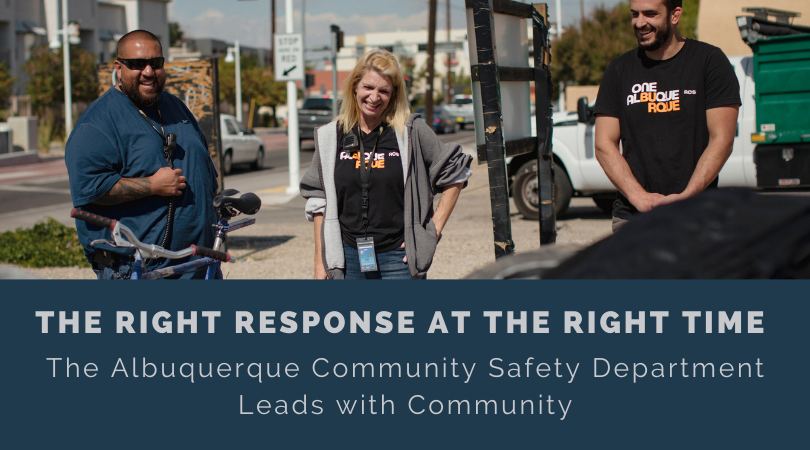The Albuquerque Community Safety (ACS) department is a new alternative response model gaining national attention, garnering recent coverage by NPR, The Washington Post, and NBC. ACS is the first of its kind. As a cabinet-level department, it is the third branch of public safety, meaning it is on equal footing with the police and fire departments.
ACS addresses calls involving mental health, homelessness, substance use, and other issues that do not require a paramedic or police officer. Calls are triaged by 911 and 311 operators, ensuring ACS’s calls are non-medical and non-violent.
ACS has several types of responders to meet the level of need assessed by dispatch. First, Mobile Crisis Team (MCT) Clinicians are independently licensed mental health professionals who co-respond with law enforcement. MCT Clinicians respond to calls identified as high-acuity emergencies related to mental and substance use disorders. Similarly, Behavioral Health Responders (BHR) have direct training and experience in mental and behavioral health and other fields such as social services and peer support, but they only respond to calls identified as not requiring police, fire, or emergency medical service response. BHRs work in teams of two and respond to calls specific to mental and substance use disorders, welfare checks, and homelessness. The other types of responders are Community Responders, Street Outreach and Resource Responders, and Community-Oriented Response & Assistance (CORA) Responders. Community Responders provide broad support to community members, from assistance with minor injuries to dealing with abandoned vehicles and needle pickups. Street Outreach and Resource Responders are a team of individuals that bridge collaboration between municipal agencies and community-based organizations to address homelessness. They also assist on the ground, conducting in-person assessments and providing referrals and linkage to other services. CORA Responders do not directly take calls for service. Rather, they organize outreach to communities affected by tragedy and violence, providing education on grief and trauma and connecting people to service providers.
Executing a cabinet-level department takes substantial planning and preparation. The process that produced ACS began more than 3 years ago, when a public safety group was convened. This group was intentionally inclusive, bringing together individuals from various departments, from police, fire, and social service agencies, to zoning and waste management departments. The group also included individuals representing Albuquerque’s Office of Civil Rights and Office of Equity and Inclusion. The public safety group examined the emergency service usage data and studied the available strategies to determine how to best respond to calls for service. (Learn more about the public safety group and its work in the January 2021 Community Engagement Report.)
Like many metro communities across the nation, Albuquerque was fraught with numerous public safety concerns beyond crime, including substance use, mental illness, and homelessness. As George Floyd’s murder raised awareness and concern about violent police encounters nationwide, a growing local focus on alternative emergency response solutions provided the city’s mayor with the momentum to launch ACS with Mariela Ruiz-Angel as the inaugural director.
Director Ruiz-Angel knows that the sustainability of this department is in the details, and she does not shy from the complexity of the challenge. When it comes to details, Ruiz-Angel admits to going so far as to research responder uniforms, learning that overly official-looking uniforms are associated with increased risk of scene escalation. Accordingly, ACS Responders are not required to wear a uniform; they are given an informal jacket and a t-shirt with the department logo. The intent is to keep responders safe by communicating a non-threatening image when they arrive on the scene.
And when it comes to complexity, it takes skill and diplomacy to navigate the nuances of institutional hierarchies like police or fire departments, not to mention securing operational elbow room without stepping on toes. Ruiz-Angel has invested the time and energy necessary to build trust with dispatch, police officers, and emergency medical and fire responders.
But Ruiz-Angel knows that building trust with the community is just as important, ensuring that community members know they can call for help and not fear violence or punishment. Transparency is supported by the dissemination of monthly informational reports that provide insight into the types of calls for service coming in, the types of responses, and outcomes from those responses. These reports include a “Win Board” where stories about successful resolutions of a selection of calls are shared.
Finally, because community partnership and leadership are what made ACS possible, the ACS model integrates community voice and those with lived experience into every facet of the department. For example, Director Ruiz-Angel proudly described the staffing process, which took longer than anticipated, but Ruiz-Angel wanted to be sure the new hires would be a good fit for the future, stressing that it wasn’t so much about background credentials but about achieving a balanced team that would be successful. This approach resulted in a broad range of skills and backgrounds among staff members, each having a voice in the development of the department. ACS staff is made up of individuals from law enforcement, social work, behavioral health, corrections, and more. Many of the staff have lived experience, and all of them share a passion for services to the community. (Learn more about developing a community safety department from ACSD’s 2022 Organizational Plan.)
Like what you’ve read? Sign up to receive the monthly GAINS eNews!


